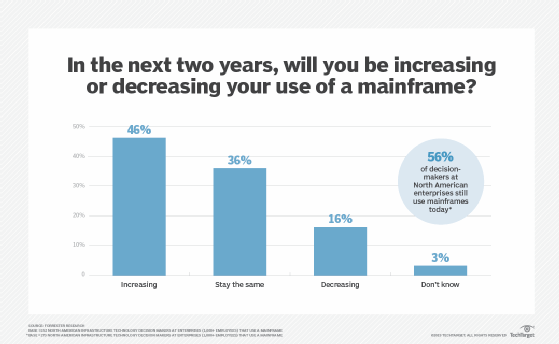
kwarkot - stock.adobe.com
Mainframe storage: Three players in a market that’s here to stay
Far from disappearing, the mainframe market and the storage it needs is here to stay for some time. The three key array makers compete with high-end flash-equipped products
Ask most people about mainframes and they’re likely to think they’re a thing from the past. In a way they’re right, of course. The mainframe has been around for half a century or more.
But mainframes are still very much alive and kicking, because they can handle massive amounts of heterogenous processing tasks, reliably and with great redundancy, and are in use at 92 of the world’s top 100 banks, 23 of the 25 top airlines, all of the world’s top 10 insurers, and 71% of Fortune 500 companies.
So, what about mainframe storage? What’s special about it? What makes it different from other high-end enterprise storage? And who supplies it?
Mainframe resurgence
Why are we talking about mainframe storage now?
It’s true that some mainframe workloads are being ported to the cloud, in particular by breaking up monolithic applications into microservices, sometimes containerised. But those mainframe applications migrated tend to be the ones enterprises can farm out to a cloud that is inherently less reliable and performant than its in-house systems.
So, there’s been something of a mainframe resurgence.
A big increase in web transactions and social security administration during the Covid-19 crisis has driven a surge in mainframe skills demand, such as in Cobol.
Elsewhere, IBM has cited its mainframe deployments’ importance to “mission-critical banking operations” during a quarter hit by the coronavirus outbreak.

IBM and mainframe storage
Mainframe computing is one area where one vendor dominates, and that’s IBM with its z/OS series operating system. The latest addition to that family came last September with the launch of the z15.
The unique thing about storage for mainframes is that it can connect via Ficon. This is IBM’s mainframe peripheral protocol, based around Fibre Channel, and it is highly performant in input/output (I/O) terms and multi-channel in operation. FICON has been around since 2000, and it appears here to stay to protect customers’ (and IBM’s) investments.
FICON-connected storage products are available from IBM, Dell EMC and Hitachi.
IBM
To coincide with the release of the z15, IBM Storage launched the DS8900F. This uses IBM’s latest Power Systems Power 9 processors.
The previous DS8880 family included all-flash, all-disk and hybrid disk, and solid-state drive options, but the DS8900F is all-flash. Maximum capacities are 5.9PB (petabytes) for the DS8950F model and 2.9PB for the DS8910F.
In terms of availability, the DS8900F offers seven nines compared with the DS8880’s six.
The same launch also saw the introduction of the z-system oriented TS7770 virtual tape library, which retains data on disk but in tape format to allow for ease of transfer to existing tape stores if needed, and once again demonstrating the importance of preservation of investment in the mainframe world.
Dell EMC
Dell EMC’s mainframe-oriented storage array is the Intel Xeon-powered PowerMax 8000 series, which boasts all-NVMe flash capacity and Intel Optane storage class memory. It is the flash era successor to EMC’s Symmetrix and VMAX products.
Naturally, the PowerMax 8000 comes with FICON connectivity, but has Ethernet and Fibre Channel ports too.
It claims up to 15 million input/output operations per second (IOPS), throughput of 350GBps and capacity of up to 4PB useable. PowerMax also has connectivity to Amazon Web Services (AWS), Azure and Google Cloud capacity.
Hitachi
Hitachi’s VSP 5000 series is its mainframe storage offering. It comes in four product options with up to 21 million IOPS claimed and bandwidth of between 25GBps and 149GBps. VSP 5000 arrays come as hybrid disk and flash with options for NVMe solid-state and storage class memory media. Capacity can be up to 69PB.
Read more about mainframes
- Google Cloud adds mainframe migration expertise via acquisition. Google Cloud’s push into large enterprise accounts continues with the acquisition of Cornerstone, but IBM has taken steps to protect its System Z installed base.
- Five considerations for mainframe decommissioning. As organisations retire mainframe systems, admins should develop a plan that addresses application migration, program replatforming, data security and hardware removal.









